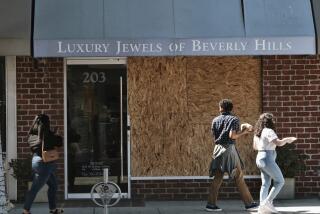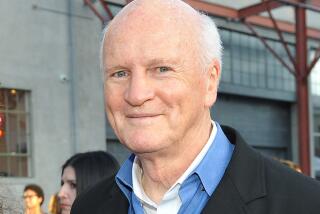Money Laundering Verdicts Conclude Jewelry District Trial : Courts: Sylmar man is convicted of participating in $350-million operation. Case is longest criminal proceeding in history of Los Angeles federal courthouse.
A jury rendered its final verdicts Friday in the longest criminal trial in the history of the Los Angeles federal courthouse by convicting a Sylmar man of participating in a ring that laundered $350 million through the downtown Los Angeles jewelry district. But a mistrial was declared on a charge that he and four other defendants conspired to aid and abet drug distribution.
Ruben Saini, 43, of Sylmar was convicted of 22 felony counts of money laundering and one count of conspiracy. He was acquitted of three counts of money laundering.
Later in the day, the jury told U.S. District Judge William D. Keller that it was irrevocably deadlocked on the drug charge and a mistrial was declared. This meant that Saini, Nazareth Andonian, Vahe Andonian, Juan Carlos Seresi and Raul Vivas escaped one of the most serious charges against them. Last week, both Andonians, Seresi and Vivas were convicted of the same conspiracy charge as Saini, as well as 25 felony counts of money laundering.
Assistant U.S. Atty. Jean Kawahara did not say whether the government would seek to retry the five defendants on the drug count.
The complicated trial consumed seven months for the presentation of evidence and 21 days of jury deliberations. Judge Keller set March 19 for sentencing.
The trial stemmed from a lengthy federal investigation called Operation Polar Cap which became public in February, 1989, when federal agents swooped through the downtown jewelry district. Ultimately, 17 people were indicted. Five were convicted, three pleaded guilty, four were acquitted and five had charges dismissed.
The government alleged that the defendants, all owners or employees of downtown jewelry businesses, had used their businesses as fronts for laundering millions in drug proceeds under the guise of legitimate gold bullion transactions in 1987 and 1988.
Lawyers for those convicted took some comfort from the jury’s deadlock on the drug count, a charge that could have increased their clients’ sentences considerably. “I think the jury’s failure to reach a result on the drug count would indicate our clients did not knowingly involve themselves in a drug conspiracy,” said Jerry L. Newton, who represented Vahe Andonian.
Three defendants in the Andonian case pleaded guilty before the trial began. The government dismissed charges against four others and Judge Keller dismissed charges against one defendant after the prosecution concluded its case. The jury last month acquitted four other defendants. Jury foreman John Streck, a West Hollywood bookkeeper, said the government simply had not presented sufficient evidence against those acquitted--Peniamin Mahseredjian, Krikor Chahinian, Joyce Momdjian and Zepur Moroyan. Lawyers for those acquitted said they thought the government had “over-reached” by indicting their clients.
Juror Lonnie Kimball said the jury failed to reach a verdict on the drug count because the government “had no proof of the cocaine. They didn’t bring it into the courtroom.” Streck said the majority of the jurors felt there was enough evidence to infer that the defendants were involved with drugs, but others simply were not convinced.
More to Read
Sign up for Essential California
The most important California stories and recommendations in your inbox every morning.
You may occasionally receive promotional content from the Los Angeles Times.










